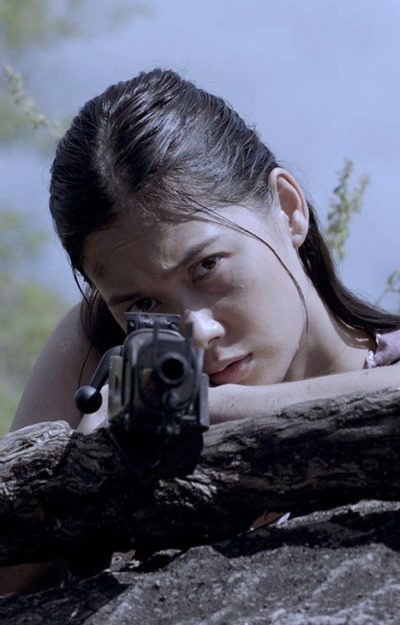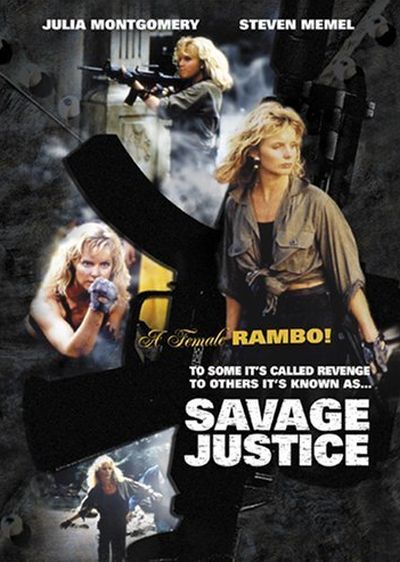★★★
“It’s not just Harlin and Anderson that work with their spouses.”
 In various places, the title for this is “a Lady”or “the Lady” fighter: I’m going with what’s firmly stated on the opening credits of the print, ungrammatical as that may be. It’s a Filipino product, but unlike the New World Pictures of the early seventies, is an entirely domestic production. Though in many ways, it feels almost like a Taiwanese chop-socky flick, taking place in a rural village, beset by bandits. Into town strolls wandering martial arts master Ming (Ortega), who agrees to teach the locals his self-defense skills, albeit only following a stern warning about what will happen if they use them for revenge or gain.
In various places, the title for this is “a Lady”or “the Lady” fighter: I’m going with what’s firmly stated on the opening credits of the print, ungrammatical as that may be. It’s a Filipino product, but unlike the New World Pictures of the early seventies, is an entirely domestic production. Though in many ways, it feels almost like a Taiwanese chop-socky flick, taking place in a rural village, beset by bandits. Into town strolls wandering martial arts master Ming (Ortega), who agrees to teach the locals his self-defense skills, albeit only following a stern warning about what will happen if they use them for revenge or gain.
While the bandits are defeated, naturally, not everyone listens. In particular, Nardo (Gonzalez) turns to the dark side, killing Ming and setting up his own, even worse, group of brigands: the Black Band. This leaves Rosa (Aristorenas, the director’s wife, and more or less the queen of local action in the seventies – credited typically as just “Virginia”) to level up her own skills – why, yes, there is a training montage, thank you for asking. This could hardly be more cliched if it tried, and even includes her sitting in the lotus position under a waterfall. With her talents suitably enhanced, she can now defend the town from the new threat, and reclaim the medallions which Ming handed out to the members of his one and only graduating class. Though she has repeatedly to be reminded not to kill her opponents: I guess Ming’s teachings weren’t quite as embedded as they could have been.
If you’re expecting this to end in a battle against Nardo, you won’t be disappointed. You may, however, be underwhelmed by the amazingly abrupt ending, which leaves the viewer uncertain as to the bad guy’s actual fate. It does also take rather too long to get to the point where the lady fights, never mind begins taking revenge. The first half is much more about Ming, and then Nardo, with Rosa sidelined. There’s an opening battle which actually occurs considerably later in the movie, and you’ve then got a good forty minutes before this even brushes against qualifying for the site.
Once it does, Mr. and Mrs. Aristorenas do a good job of making up for lost time. She has decent skills, and he knows how to film them, with long, unbroken shots and in a way which makes it clear Virginia isn’t being doubled. The only print that appears available, is dubbed into English with Greek subtitles; it’s not bad, with the English being locally-accented, and sounding like it was done by Filipino natives rather than Eton graduates, as was often the case for Hong Kong films. However, it’s also cropped to 4:3 ratio, and this definitely does hamper the impact at some points. It’s still a brisk, energetic affair, with unexpected elements such as both heroes and villains being residents of the same village.
Dir: Jun Aristorenas
Star: Virginia Aristorenas, Rolando Gonzales, Ernie Ortega, Teroy De Guzman
a.k.a. Buhawi






 The heroine here, Mariano (Salvador), has to count as the baddest bitch I’ve seen in quite a long time. In terms of being a sheer, unstoppable force, she’s right up there with Jen from
The heroine here, Mariano (Salvador), has to count as the baddest bitch I’ve seen in quite a long time. In terms of being a sheer, unstoppable force, she’s right up there with Jen from 


 In an unnamed third-world country, which looks suspiciously like the Philippines, unexpected turmoil catches American diplomats by surprise. Trying to flee the country, the Howard family are caught by the rebel force run by Sanchez (Vernal). Mom and Dad are killed, while daughter Sarah (Montgomery) is abducted by the rebel leader. Fast-forward a year, and it looks like Sarah has gone more or less full Patty Hearst. She has joined the revolution and become Sanchez’s main squeeze – much to the unhappiness of the previous incumbent. But, it turns out, Sarah was only playing a (very) long game, and waiting for the appropriate opportunity. When she goes along on a raid of a nearby town, she jumps ship, instead teaming up with local guy Rick (Memel) to defend the locals against Sanchez and his gang, intent on extracting revenge for her year of abuse. And she knows the location of the perfect arms cache which will help them. Though getting to it might be another matter.
In an unnamed third-world country, which looks suspiciously like the Philippines, unexpected turmoil catches American diplomats by surprise. Trying to flee the country, the Howard family are caught by the rebel force run by Sanchez (Vernal). Mom and Dad are killed, while daughter Sarah (Montgomery) is abducted by the rebel leader. Fast-forward a year, and it looks like Sarah has gone more or less full Patty Hearst. She has joined the revolution and become Sanchez’s main squeeze – much to the unhappiness of the previous incumbent. But, it turns out, Sarah was only playing a (very) long game, and waiting for the appropriate opportunity. When she goes along on a raid of a nearby town, she jumps ship, instead teaming up with local guy Rick (Memel) to defend the locals against Sanchez and his gang, intent on extracting revenge for her year of abuse. And she knows the location of the perfect arms cache which will help them. Though getting to it might be another matter. Proof that a lack of originality is not necessarily a bar to being an entertaining movie, this pulls together elements from all over the place, but probably most notably, The Long Kiss Goodnight and John Wick. You have the “former assassin now leading an idyllic family life, until her past catches up with her” of the former. And the “Oh, they’re surely not going to kill tha… Hoo-boy. The hero/ine is going to be VERY angry with them” of the latter, among other elements.
Proof that a lack of originality is not necessarily a bar to being an entertaining movie, this pulls together elements from all over the place, but probably most notably, The Long Kiss Goodnight and John Wick. You have the “former assassin now leading an idyllic family life, until her past catches up with her” of the former. And the “Oh, they’re surely not going to kill tha… Hoo-boy. The hero/ine is going to be VERY angry with them” of the latter, among other elements. The unapologetically brutal war on drugs being waged in the Philippines by hard-line President Rodrigo Duterte has come in for criticism abroad – and this film chips in to the argument from his home turf. Philippines DEA agent Nina Manigan (Curtis) is assigned to a new team, the sole survivor of her previous squad, killed after being betrayed to the drug gangs. Their new mission is to arrest leading boss Biggie Chen (Atayde), luring him out of the slum where he operates to a more vulnerable spot. However, at the last second, Chen changes the location of the meet, and despite misgivings, the squad enter the Gracia ni Maria area which is Chen’s home turf. To no great surprise, this turns out to be an ambush. Half the squad is wiped out in the initial assault, and with Chen jamming their calls for backup, Nina and the surviving members have to try and make their way out of a severely hostile environment.
The unapologetically brutal war on drugs being waged in the Philippines by hard-line President Rodrigo Duterte has come in for criticism abroad – and this film chips in to the argument from his home turf. Philippines DEA agent Nina Manigan (Curtis) is assigned to a new team, the sole survivor of her previous squad, killed after being betrayed to the drug gangs. Their new mission is to arrest leading boss Biggie Chen (Atayde), luring him out of the slum where he operates to a more vulnerable spot. However, at the last second, Chen changes the location of the meet, and despite misgivings, the squad enter the Gracia ni Maria area which is Chen’s home turf. To no great surprise, this turns out to be an ambush. Half the squad is wiped out in the initial assault, and with Chen jamming their calls for backup, Nina and the surviving members have to try and make their way out of a severely hostile environment. I should start by explaining the above tagline. The main monster here is the aswang, a female vampiric creature from Philippines folklore. Its main distinguishing feature, is that after passing for human during the day, at night it splits its body in two, and the top half then flies around, killing people and eating their entrails, using a super-long tongue. There is a secret group, tasked with keeping mankind both safe and unaware of these, as well as any other creatures that go bump in the night. One of its top agents is Mahal (Dennis), who has a particular interests in aswangs (aswangii?), since she blames them for the death of her father.
I should start by explaining the above tagline. The main monster here is the aswang, a female vampiric creature from Philippines folklore. Its main distinguishing feature, is that after passing for human during the day, at night it splits its body in two, and the top half then flies around, killing people and eating their entrails, using a super-long tongue. There is a secret group, tasked with keeping mankind both safe and unaware of these, as well as any other creatures that go bump in the night. One of its top agents is Mahal (Dennis), who has a particular interests in aswangs (aswangii?), since she blames them for the death of her father. Both Bell and Katon had worked with Santiago before, in
Both Bell and Katon had worked with Santiago before, in